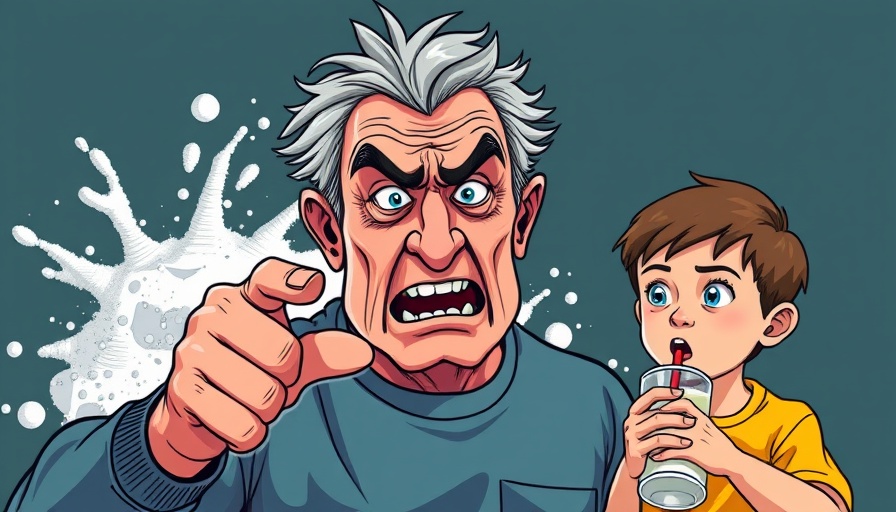
Understanding the Food Revolution: RFK Jr.'s Bold Measures
In the recent video titled 10 Dangerous Foods RFK Jr Just BANNED ❌, Robert F. Kennedy Jr. makes a daring move against the American food industry's unsavory practices. By highlighting the dangers of common ingredients found in many meals, his campaign calls for a fundamental shift in how we view our food. For health-conscious adults in Metro Atlanta, this conversation is timely and essential as we confront the reality of the foods we consume and their effects on our bodies.
In 10 Dangerous Foods RFK Jr Just BANNED ❌, the discussion dives into harmful ingredients affecting our health, exploring key insights that sparked deeper analysis on our end.
The Dangers of Seed Oils and Why They Need to Go
At the forefront of RFK Jr.'s concerns is the widespread use of industrial seed oils. Often labeled as the "hateful eight," these oils—such as canola and soybean—are not only omnipresent in fast foods but also linked to severe health issues like inflammation and heart disease. In a world where convenience often trumps health, many unknowingly indulge in these toxic ingredients. Kennedy advocates for switching back to traditional fats like beef tallow and extra virgin olive oil, which have remained staples throughout history. The consumption of these oils raises crucial questions about the integrity of our food supply.
Colorful but Dangerous: The Case Against Artificial Food Dyes
RFK Jr. also takes a firm stand against artificial food dyes, which are prolific in products targeted at children. The startling revelation that these brightly colored additives could contribute to behavioral issues and allergic reactions prompts serious reevaluation of our food choices. Dyes derived from petroleum are a stark reminder of the lengths manufacturers will go to enhance visual appeal at the expense of health. Natural alternatives like beet juice offer a healthier route without compromising safety.
Questionable Sweeteners: Are They Really 'Guilt-Free'?
Next on the list are artificial sweeteners, like aspartame and sucralose, which present a paradox of guilt-free eating. Many, including Kennedy, believe these sweeteners may negatively impact our gut health and contribute to weight gain—defeating their purpose as diet alternatives. With the World Health Organization now flagging aspartame as a potential carcinogen, it’s time to rethink our approach to sweetness and incorporate natural substitutes like stevia instead.
The Silent Epidemic: High Fructose Corn Syrup
Additionally, high fructose corn syrup (HFCS) lurks in countless foods, seeping into our diets without our acknowledgment. This ubiquitous ingredient is not just a sweetener but a primary enemy of metabolic health, associated with rising obesity rates and insulin resistance. Kennedy’s campaign raises awareness about how something so cheap and pervasive can be detrimental to public health—advocating for transparency from food manufacturers.
The Push for Clear Labeling: Ultra-Processed Foods Uncovered
With the growing prevalence of ultraprocessed foods, understanding what we eat has never been more critical. These foods, designed for convenience and shelf stability, often harbor hidden dangers. Processed noodles, frozen pizzas, and snack cakes bombard us with additives that contribute to chronic health issues. The push for clearer labeling and stricter regulations could be transformative for consumers who wish to make healthier choices.
Making Breakfast Healthier: The Sugary Reality of Cereal and Yogurt
Even breakfast staples such as sugary cereals and flavored yogurts are not exempt from scrutiny. Often marketed as healthy, they are brimming with sugar and artificial flavors, contributing to childhood obesity. By educating ourselves on better breakfast options, we can instill healthier habits from an early age. Simply choosing whole foods can pave the way for a healthier start to the day.
Processed Meat: The Hidden Health Hazard
Processed meats pose another significant health risk, stocked with preservatives that may contribute to chronic conditions like cancer. As Kennedy emphasizes, these products often mask their true nutritional profile beneath a layer of marketing. Advocating for fewer processed meats in our diets can lead to healthier family meals and school lunches.
Preserving Our Food: Recognizing Toxic Additives
When it comes to food preservation, not all chemicals are created equal. Kennedy's call to action around toxic preservatives and additives serves as a wake-up call; many of these compounds are already banned in other countries. Pushing back against the normalcy of these chemicals may foster a food industry that prioritizes safety over shelf life.
The Caffeine Craze: Evaluating Energy Drinks
Finally, the rise of energy drinks, often laden with sugar and caffeine, raises red flags about youth engagement with unhealthy beverages. As Kennedy warns, the adverse effects of these drinks demand more transparency in marketing and health advisories, especially directed at kids. Encouraging healthier energy alternatives could lead to more sustainable energy sources.
Towards a Safer Food System: The Future We Deserve
RFK Jr.’s focus on eliminating toxins, sugar overload, and synthetic ingredients from our diet sends a powerful message: consumer demands can lead to systemic change. With more awareness, we can collectively push for a food system that favors health and transparency over profit and convenience.
No matter your political views, the fight for a cleaner food supply is a battle we can all rally behind. It’s not just about banning foods; it’s about understanding the impact of our choices and ensuring our health and that of future generations are safeguarded. The next time you shop for groceries, consider how you can make more informed choices.
 Add Row
Add Row  Add
Add 




Write A Comment